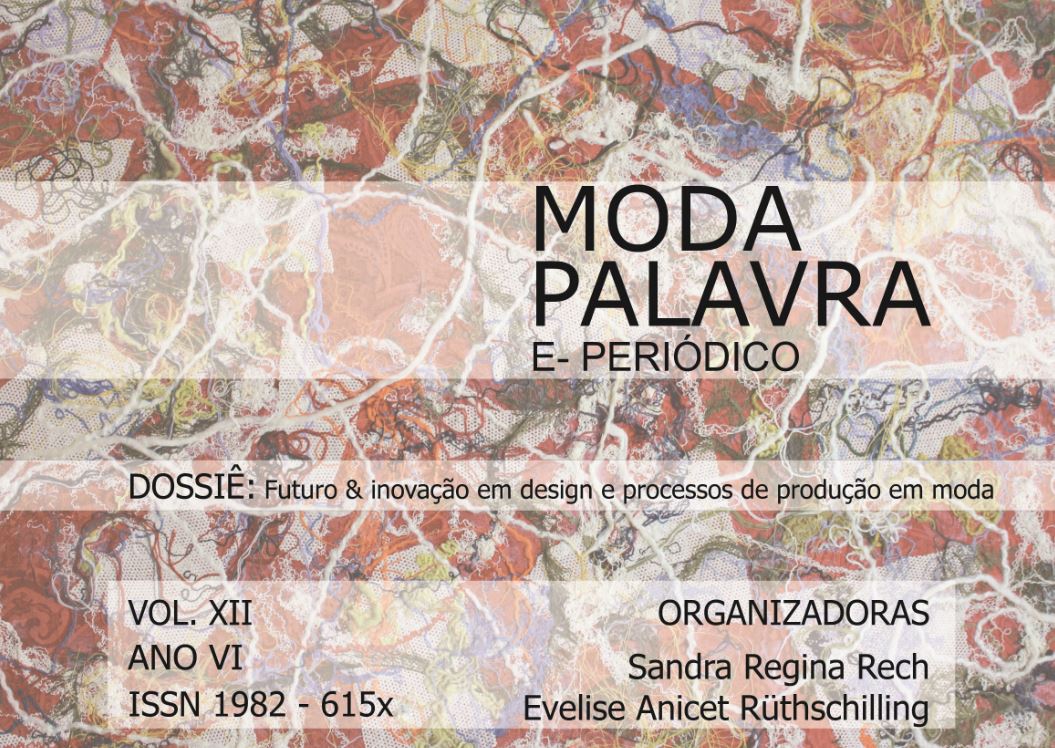O modelo CEvI para o design de moda-vestuário: corpo, estilo de vida e identidade
DOI:
https://doi.org/10.5965/1982615x06122013080Palabras clave:
indicador de consumo, gestão do design, tomada de decisãoResumen
Na indústria de moda há uma tendência a minimizar a importância dos aspectos tangíveis. Considerando que os métodos para o desenvolvimento de produtos de moda-vestuário precisam incluir valores tangíveis e intangíveis, propõe-se o estudo de três dimensões essenciais: a identidade, o estilo de vida e a condição corpórea. Por fim, apresenta-se a classificação dos Indicadores de Moda-Vestuário segundo o modelo CEvI, no intuito de comunicar o valor adicionado por meio de benefícios e atributos.Descargas
Citas
ABERNATHY, F.; DUNLOP, J. T.; HAMMOND, J. & WEIL, D. A Stitch in Time. Oxford: Oxford University Press, 1999.
CANADA. Gender-Based Analysis+. Status of Women Canada, 2013. Disponível em http://www.swc-cfc.gc.ca/pol/gba-acs/index-eng.html. Acesso em 20/03/2013.
COOPER, R. & PRESS, M. The Design Agenda: a guide to successful design management. Chichester: Wiley, 1995.
FLÜGEL, J. C. A psicologia das roupas. São Paulo: Editora Mestre Jou, 1966.
FRISBY, D.; FEATHERSTONE, M. Simmel on Culture. London: Sage, 1997.
HENLEY CENTRE. Economic Forecasting Report. London: The Henley Centre, 2002.
JORDAN, P. W. Designing Pleasurable Products: an introduction to the new human factors. London: Taylor & Francis, 2000.
KAWAMURA, Y. Fashion-ology. Oxford: Berg, 2005.
LI, Z. “Functional Clothing Design for the Active Grey Market”. In: Include 2003 Conference. Proceedings of Include 2003 Conference. London, Royal College of Art, 2003.
LIPOVETSKY, G. A felicidade paradoxal: ensaio sobre a sociedade de hiperconsumo. São Paulo: Companhia das Letras, 2007.
LTANEN, S. “Ageless and ageing: a survey of fashion designers and their conceptions of the target group”. In: Include 2003 Conference. Proceedings of Include 2003 Conference. London, Royal College of Art, 2003.
MASLOW, A. H. Motivation and Personality. New York: Harper Collins Publishers, 1987.
McCRACKEN, G. "Culture and Consumption: A Theoretical Account of the Structure and Movement of the Cultural Meaning of Consumer Goods. Journal of Consumer Research, Vol. 13, pp. 71-84, 1986.
POPCORN, F., MARIGOLD, L. Click: 16 tendências que irão transformar sua vida, seu trabalho e seus negócios no futuro. Tradução de Ana Gibson. Rio de Janeiro: Campus, 1997.
ROCHA, M. A. V.; HAMMOND, L. & HAWKINS, D. Age, Gender and National Factors in Fashion Consumption. Journal of Fashion Marketing and Management, Volume 9, Issue 4, pp. 380-390, 2005.
ROCHA, M. A. V. Study of Consumer Clothing Behaviour and its Relevance to Successful Fashion Product Development. 2007. Thesis (PhD in Fashion Design). University College for the Creative Arts/University of Kent, United Kingdom.
SIMMEL, G. The Philosophy of Fashion. In: FRISBY, D. & FEATHERSTONE, M. (ed.) Simmel on Culture. London: Sage, 1997.
SOLOMON, M. & RABOLT, N. J. Consumer Behaviour in Fashion. Upper Saddle River, NJ: Prentice Hall, 2004. WACOAL. Spiral Ageing. The Human Research Center, 2000. Disponível em http://www.wacoal.ph/mvc/page/p-4. Acesso em 20/03/2013.
ZHANG, Z; LI, Y; GONG, C; WU, H. “Casual wear product attributes: a Chinese consumers’ perspective”. Journal of Fashion Marketing and Management, v6 n1, pp.53-62, 2002.
Descargas
Publicado
Cómo citar
Número
Sección
Licencia
Derechos de autor 2013 Maria Alice Vasconcelos Rocha

Esta obra está bajo una licencia internacional Creative Commons Atribución-NoComercial 4.0.
Al enviar un artículo para su publicación en ModaPalavra e-periodico, el (los) autor (es) aceptan los siguientes términos:
- Los autores mantienen los derechos de autor y otorgan a la revista el derecho a la primera publicación, con el trabajo licenciado simultáneamente bajo Creative Commons Attribution-NonCommercial 4.0 International, que permite compartir el trabajo con reconocimiento de autoría y publicación inicial en esta revista, sin pago;
- Los autores pueden utilizar los mismos resultados en otras publicaciones después de la primera publicación, siempre que indiquen ModaPalavra e-periodical como medio de publicación original;
- Los autores pueden asumir contratos adicionales por separado solo después de la publicación inicial en ModaPalavra e-periodical, siempre que indiquen ModaPalavra e-periodic como el medio de publicación original;
- Se permite y anima a los autores a publicar y distribuir su trabajo en línea (por ejemplo, en repositorios institucionales o en su página personal), solo después del proceso editorial y la primera publicación, siempre que indiquen el ModaPalavra periódico electrónico como medio de publicación original;
- Para indicar ModaPalavra e-periodic como medio de publicación original, el autor debe seguir el texto modelo: "Este artículo fue publicado originalmente por ModaPalavra e-periodic, bajo la licencia CC BY NC, en su volumen [insertar volumen], número [ insertar número] en el año de [insertar año], y se puede acceder en: http://www.revistas.udesc.br/index.php/modapalavra/ ";
- Las opiniones expresadas en los artículos son responsabilidad exclusiva de los autores y no reflejan necesariamente la opinión de la revista. La publicación de artículos, fotografías y dibujos fue previamente autorizada por los responsables o sus representantes para su publicación en ModaPalavra e-periodic.









